
|
Now it is bright as 8.8 mag (Apr. 20, Maik Meyer). It keeps 9-10 mag for a while until July. In the Northern Hemisphere, it is observable in the evening low sky from late April to mid May. It will be unobservable after that. But it will appear in the morning sky again at 12 mag in late August, then it will be fading slowly in the low sky. In the Southern Hemisphere, it is not observable until August. But it keeps observable in good condition for a long time after August.
Date(TT) R.A. (2000) Decl. Delta r Elong. m1 Best Time(A, h)
Apr. 25 2 30.57 55 38.5 1.832 1.289 42 8.9 20:11 (149, 15)
May 2 3 20.49 53 27.5 1.890 1.277 39 8.9 20:19 (146, 15)
|

|
Now it is so bright as 8.9 mag (Apr. 23, Chris Wyatt). It was origianlly predicted to be 15 mag, but actually, it is much brighter than expected now. The condition is excellent in the Southern Hemisphere, and it keeps visible with binoculars until summer. In the Northern Hemisphere, it is only observable from early June to mid August in the evening low sky.
Date(TT) R.A. (2000) Decl. Delta r Elong. m1 Best Time(A, h)
Apr. 25 21 2.39 -55 41.6 1.607 1.950 93 9.5 3:44 (335, -9)
May 2 20 40.87 -59 12.0 1.426 1.917 102 9.0 3:34 (342, -9)
|

|
It is already so bright as 8.9 mag (Apr. 21, Juan Jose Gonzalez). It is expected to reach to 8 mag in 2009 summer. It will be observable at 8-10 mag in good condition for a long time until late autumn.
Date(TT) R.A. (2000) Decl. Delta r Elong. m1 Best Time(A, h)
Apr. 25 22 51.89 34 15.9 3.766 3.205 49 9.2 3:44 (247, 31)
May 2 22 52.24 34 28.3 3.683 3.191 53 9.1 3:34 (249, 34)
|
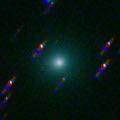
|
Now it is bright as 9.1 mag (Apr. 23, Marco Goiato). It keeps 10 mag until June. In the Northern Hemisphere, it is visible in the morning low sky now. However, it moves southwards very quickly. It is only observable until the end of April, and it will never be observable again after May. In the Southern Hemisphere, it keeps observable in a good condition for a long time.
Date(TT) R.A. (2000) Decl. Delta r Elong. m1 Best Time(A, h)
Apr. 25 23 3.95 -10 15.6 1.441 1.137 51 9.9 3:44 (286, 5)
May 2 23 21.30 -15 58.9 1.326 1.156 57 9.7 3:34 (290, 1)
|
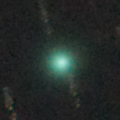
|
It brightened rapidly, and it reached up to 7.5 mag on Apr. 5 (Juan Jose Gonzalez). Now it is appearing in the morning sky again. It will be getting higher gradually after this, and it keeps observable until it has gone away. However, the comet will fade out very rapidly. It will be too faint to see visually in late May.
Date(TT) R.A. (2000) Decl. Delta r Elong. m1 Best Time(A, h)
Apr. 25 1 4.57 30 24.3 1.512 0.705 22 9.9 3:44 (236, 5)
May 2 0 49.09 30 48.4 1.502 0.791 29 10.9 3:34 (240, 11)
|

|
Now it is 9.1 mag, already so bright (Apr. 21, Juan Jose Gonzalez). It will be bright at 9-10 mag for a long time from spring to autumn.
Date(TT) R.A. (2000) Decl. Delta r Elong. m1 Best Time(A, h)
Apr. 25 20 21.98 -15 46.1 1.240 1.607 90 10.1 3:44 (319, 29)
May 2 20 40.51 -14 54.0 1.185 1.595 92 9.9 3:34 (319, 29)
|
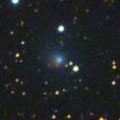
|
It is already so faint as 9.5 mag (Apr. 16, Marco Goiato). It will reach to 9 mag in June. Now it is moving southwards very fast. In the Northern Hemisphere, it is getting lower very rapidly, and it will never be observable again after June. In the Southern Hemisphere, it keeps observable for a long time after this in the evening sky.
Date(TT) R.A. (2000) Decl. Delta r Elong. m1 Best Time(A, h)
Apr. 25 5 53.39 30 28.7 1.756 1.423 54 10.1 20:11 (106, 34)
May 2 6 9.63 26 38.4 1.765 1.369 50 9.9 20:19 (104, 28)
|

|
It passed near by the earth in late February, and it reached up to 4.9 mag (Feb. 23, Juan Jose Gonzalez). The coma extended up to 20 arcmin, and the anti-tail was clearly visible. Now it is fading rapidly. It has already faded down to 10.0 mag (Apr. 21, Marco Goiato). Because moving along the retrograde orbit, it will be lower rapidly in the evening sky. It will be too low to observe at 12 mag in late May.
Date(TT) R.A. (2000) Decl. Delta r Elong. m1 Best Time(A, h)
Apr. 25 6 34.68 22 24.0 2.201 1.965 63 10.4 20:11 ( 92, 38)
May 2 6 35.42 22 22.8 2.414 2.040 56 10.8 20:19 ( 97, 31)
|
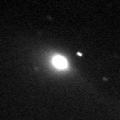
|
It has brightened very rapidly, faster than expected. Now it is so bright as 9.6 mag (Apr. 20, Juan Jose Gonzalez). It will be fading gradually after this. It will be too low to observe in the evening at 13 mag in late June.
Date(TT) R.A. (2000) Decl. Delta r Elong. m1 Best Time(A, h)
Apr. 25 5 10.67 27 20.9 1.948 1.417 44 11.2 20:11 (107, 24)
May 2 5 37.85 27 54.9 2.009 1.457 43 11.3 20:19 (109, 23)
|

|
It has already brightened up to 10.8 mag (Apr. 21, Marco Goiato). It is expected to brighten up to 10 mag from late 2009 to early 2010. Good condition in the Southern Hemisphere. In the Northern Hemisphere, it is observable in the evening low sky from February to April. Then it becomes unobservable until September. But after October, it is observable at 10 mag for a while in good condition. In the Southern Hemisphere, it keeps observable for a long time while brightening until June when it brightens to 11 mag. But it becomes unobservable around and after the brightest time.
Date(TT) R.A. (2000) Decl. Delta r Elong. m1 Best Time(A, h)
Apr. 25 6 9.25 -20 12.4 3.145 2.913 67 11.4 20:11 ( 59, 8)
May 2 6 18.95 -18 0.7 3.159 2.866 64 11.4 20:19 ( 64, 5)
|

|
It brightened much faster than expected, and reached up to 8.4 mag (Jan. 30, Juan Jose Gonzalez). It was very large and visible through binoculars. It will be fading after this, but still bright as 11.1 mag (Apr. 22, Carlos Labordena). It keeps locating high in the evening sky for a while. It keeps higher than 40 degree until mid May when it fades down to 14 mag.
Date(TT) R.A. (2000) Decl. Delta r Elong. m1 Best Time(A, h)
Apr. 25 8 14.53 14 49.6 1.457 1.737 87 12.6 20:11 ( 64, 54)
May 2 8 32.38 13 59.9 1.550 1.779 85 13.0 20:19 ( 67, 51)
|

|
It brightened up to 9.8 mag in December and January (Dec. 28, Juan Jose Gonzalez). Now it is fading, but still bright as 12.0 mag (Apr. 22, Carlos Labordena). It keeps visible visually for a long time until June when it becomes low in the evening at 13 mag.
Date(TT) R.A. (2000) Decl. Delta r Elong. m1 Best Time(A, h)
Apr. 25 7 7.66 31 58.7 3.600 3.390 69 12.6 20:11 (100, 49)
May 2 7 16.29 30 56.8 3.739 3.439 65 12.8 20:19 (102, 43)
|
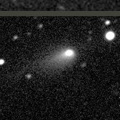
|
Now it is very bright as 11.8 mag (Apr. 22, Carlos Labordena). It keeps observable in good condition until May, then it keeps observable until July when it becomes too low in the evening sky, around 12-13 mag for a long time.
Date(TT) R.A. (2000) Decl. Delta r Elong. m1 Best Time(A, h)
Apr. 25 9 30.13 17 37.2 1.785 2.257 104 12.7 20:11 ( 39, 69)
May 2 9 36.22 16 51.6 1.850 2.244 99 12.7 20:19 ( 51, 64)
|

|
It brightened up to 11.5 mag in last summer (Aug. 4, Marco Goiato). Although it is not observable in the Northern Hemisphere, it keeps observable in good condition for a long time in the Southern Hemisphere. However, no visual observations have been reported since last summer. Recent CCD observations suggest that it is still visible visually around 12-13 mag.
Date(TT) R.A. (2000) Decl. Delta r Elong. m1 Best Time(A, h)
Apr. 25 4 9.86 -53 8.8 3.305 3.127 71 13.0 20:11 ( 44,-29)
May 2 4 24.16 -50 50.6 3.361 3.165 70 13.1 20:19 ( 47,-32)
|

|
Since the major outburst in last September, with a new outburst in December, it has been so bright as 10-11 mag for about half a year. Now it is still bright as 11.8 mag (Apr. 20, Juan Jose Gonzalez).
Date(TT) R.A. (2000) Decl. Delta r Elong. m1 Best Time(A, h)
Apr. 25 7 46.41 22 39.5 6.225 6.124 79 13.9 20:11 ( 81, 53)
May 2 7 49.18 22 26.7 6.336 6.126 73 13.9 20:19 ( 86, 46)
|

|
The condition of this return is bad, and it has not been observed yet. It will appear in the morning low sky at 13.5 mag in June. Then it will be getting higher gradually while fading slowly.
Date(TT) R.A. (2000) Decl. Delta r Elong. m1 Best Time(A, h)
Apr. 25 0 41.81 9 43.0 2.390 1.504 21 14.1 3:44 (256, -4)
May 2 1 3.17 12 9.3 2.348 1.473 22 13.9 3:34 (253, -3)
|

|
It reached to 10.9 mag in May (May 11, Marco Goiato). It is fading slowly. Now it is 13.5 mag (Apr. 1, Juan Jose Gonzalez), still visible visually. It keeps bright as 13-14 mag for a long time after this until summer.
Date(TT) R.A. (2000) Decl. Delta r Elong. m1 Best Time(A, h)
Apr. 25 16 45.14 31 57.0 3.413 4.032 121 13.9 2:34 ( 0, 87)
May 2 16 41.81 33 22.9 3.444 4.080 122 14.0 2:03 ( 0, 88)
|
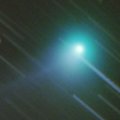
|
It reached to 6.3 mag in September in the southern sky (Sept. 4, Marco Goiato). Now it is fading. Although it has already become fainter than 16 mag by CCD observations, it seems to be still visible visually around 14 mag.It keeps observable in the northern sky while fading gradually. In the Southern Hemisphere, it will never be observable again.
Date(TT) R.A. (2000) Decl. Delta r Elong. m1 Best Time(A, h)
Apr. 25 23 0.96 69 23.6 3.451 3.136 63 14.1 3:44 (205, 37)
May 2 23 20.96 71 34.9 3.539 3.214 63 14.3 3:34 (203, 37)
|
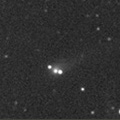
|
Now it is 13.3 mag and visible visually (Apr. 22, Marco Goiato). It will brighten up to 12-13 mag in 2010 summer. In 2009, it keeps observable in good condition until summer.
Date(TT) R.A. (2000) Decl. Delta r Elong. m1 Best Time(A, h)
Apr. 25 11 57.23 14 4.6 2.217 3.034 137 14.3 21:42 ( 0, 69)
May 2 11 54.32 13 51.0 2.261 3.013 130 14.3 21:12 ( 0, 69)
|

|
Now it is 13.7 mag (Apr. 21, Juan Jose Gonzalez). It had been bright and visible visually around 13 mag from spring to autumn in 2008. It will be visible visually at 14 mag again until summer.
Date(TT) R.A. (2000) Decl. Delta r Elong. m1 Best Time(A, h)
Apr. 25 14 10.27 37 19.8 5.824 6.511 129 14.8 23:54 (180, 88)
May 2 14 1.97 37 44.8 5.889 6.536 126 14.9 23:19 (180, 87)
|

|
Now it is visible visually at 13.8 mag (Mar. 21, Jose Carvajal). It will be observable at 15 mag in good condition in spring.
Date(TT) R.A. (2000) Decl. Delta r Elong. m1 Best Time(A, h)
Apr. 25 11 35.69 7 33.1 1.530 2.363 136 14.9 21:21 ( 0, 62)
May 2 11 32.31 6 16.2 1.581 2.354 129 14.9 20:50 ( 0, 61)
|
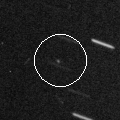
|
It passed near by the earth in April. It brightened up to 14.3 mag and became visible visually (Apr. 22, Alan Hale). It will be fading after this, and will be fainter than 18 mag in August. It moves southward very rapidly, and it will locate very low after late May in the Northern Hemisphere.
Date(TT) R.A. (2000) Decl. Delta r Elong. m1 Best Time(A, h)
Apr. 25 21 46.38 5 51.3 0.286 0.924 65 15.2 3:44 (285, 30)
May 2 22 7.05 -3 54.8 0.314 0.944 69 15.4 3:34 (293, 23)
|
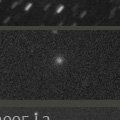
|
Now it is 16.2 mag (Mar. 31, Catalina Sky Survey). It will be brightening rapidly after this, and will be 10 mag in autumn. It keeps observable for a long time until 2010 February. But in the Northern Hemisphere, it will be lower than 20 degree after July when it becomes about 13 mag, then it keeps very low all through the brightest time. It locates a bit higher in the Southern Hemisphere.
Date(TT) R.A. (2000) Decl. Delta r Elong. m1 Best Time(A, h)
Apr. 25 12 38.82 0 49.4 1.236 2.182 153 15.5 22:23 ( 0, 56)
May 2 12 32.19 1 11.7 1.230 2.136 145 15.2 21:49 ( 0, 56)
|

|
It brightened up to 12.7 mag in 2008 spring (Apr. 12, Marco Goiato). But it faded down to 14.9 mag in July (July 22, Mitsunori Tsumura). In the Southern Hemisphere, it will be observable in good condition after this. It will never be observable again in the Northern Hemisphere.
Date(TT) R.A. (2000) Decl. Delta r Elong. m1 Best Time(A, h)
Apr. 25 20 9.46 -50 44.1 3.514 3.823 100 15.3 3:44 (340, -1)
May 2 20 14.27 -51 24.3 3.472 3.864 105 15.3 3:34 (342, 0)
|

|
Now it is 14.5 mag and visible visually (Mar. 22, Juan Jose Gonzalez). It will be observable at 15-16 mag in good condition for a while.
Date(TT) R.A. (2000) Decl. Delta r Elong. m1 Best Time(A, h)
Apr. 25 9 9.62 23 32.3 3.292 3.574 97 15.6 20:11 ( 60, 70)
May 2 9 13.14 23 7.0 3.389 3.571 92 15.7 20:19 ( 70, 64)
|
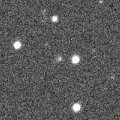
|
Now it is 16.3 mag (Mar. 20, H. Sato). It will brighten up to 15 mag in 2009 and 2010, and will be observable for a long time in good condition.
Date(TT) R.A. (2000) Decl. Delta r Elong. m1 Best Time(A, h)
Apr. 25 21 46.47 34 26.6 3.524 3.193 62 16.3 3:44 (253, 43)
May 2 21 44.28 36 52.6 3.405 3.160 67 16.2 3:34 (252, 48)
|

|
It will be fading after this, and will be fainter than 18 mag in July.
Date(TT) R.A. (2000) Decl. Delta r Elong. m1 Best Time(A, h)
Apr. 25 14 24.58 -21 10.6 1.934 2.933 171 16.3 0:14 ( 0, 34)
May 2 14 14.91 -17 42.2 1.976 2.980 174 16.4 23:32 ( 0, 38)
|
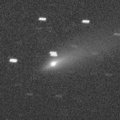
|
It reached up to 9.6 mag in summer (Aug. 2, Juan Jose Gonzalez). Now it is fading. It has already faded down to 16.4 mag (Apr. 4, Ken-ichi Kadota). It keeps observable in good condition until June when it becomes fainter than 18 mag.
Date(TT) R.A. (2000) Decl. Delta r Elong. m1 Best Time(A, h)
Apr. 25 12 40.99 38 6.0 2.306 2.995 124 16.4 22:26 (180, 87)
May 2 12 35.80 37 0.3 2.404 3.041 120 16.5 21:53 (180, 88)
|

|
Now it is 17.7 mag (Apr. 8, Yasukazu Ikari). It will brighten rapidly after this, and it is expected to be observable at 10-11 mag in a good condition for a long time from summer to winter.
Date(TT) R.A. (2000) Decl. Delta r Elong. m1 Best Time(A, h)
Apr. 25 20 58.87 -11 54.6 1.928 2.032 81 16.9 3:44 (309, 26)
May 2 21 13.51 -11 12.6 1.802 1.975 84 16.6 3:34 (309, 27)
|
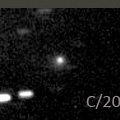
|
It reached up to 16.4 mag in spring (Mar. 14, Ken-ichi Kadota). It will be fading after this, and will be fainter than 18 mag in July.
Date(TT) R.A. (2000) Decl. Delta r Elong. m1 Best Time(A, h)
Apr. 25 15 30.32 36 45.1 2.469 3.174 126 16.7 1:20 (180, 88)
May 2 15 8.06 36 35.3 2.484 3.200 127 16.7 0:30 (180, 88)
|

|
It is still bright as 15.7 mag (Apr. 2, Ken-ichi Kadota). But it will be fainter than 18 mag in July.
Date(TT) R.A. (2000) Decl. Delta r Elong. m1 Best Time(A, h)
Apr. 25 11 13.15 -1 36.5 3.389 4.159 134 16.8 20:58 ( 0, 53)
May 2 11 11.15 -0 4.7 3.527 4.211 127 16.9 20:29 ( 0, 55)
|

|
Peculiar asteroid moving along a cometary orbit. It will fade out very rapidly after May.
Date(TT) R.A. (2000) Decl. Delta r Elong. m1 Best Time(A, h)
Apr. 25 14 2.41 -2 59.1 1.283 2.280 169 16.8 23:47 ( 0, 52)
May 2 13 55.66 -3 0.2 1.342 2.327 164 17.1 23:13 ( 0, 52)
|

|
Now it is 16.8 mag (Mar. 15, Ken-ichi Kadota). It will reach to 15 mag in 2010. It keeps observable for a long time after this in the Northern Hemisphere.
Date(TT) R.A. (2000) Decl. Delta r Elong. m1 Best Time(A, h)
Apr. 25 15 32.23 1 11.1 5.176 6.103 155 16.9 1:21 ( 0, 56)
May 2 15 29.27 2 5.5 5.120 6.068 158 16.9 0:51 ( 0, 57)
|
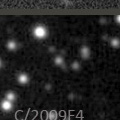
|
It will reach up to 14-15 mag from 2011 to 2012. Now it is 17 mag and locates low in the south.
Date(TT) R.A. (2000) Decl. Delta r Elong. m1 Best Time(A, h)
Apr. 25 15 33.32 -24 19.1 7.834 8.772 157 17.4 1:22 ( 0, 31)
May 2 15 29.71 -24 28.9 7.761 8.736 164 17.4 0:51 ( 0, 30)
|
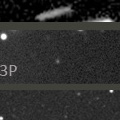
|
It reached 16.9 mag at opposition in March (Mar. 28, Ken-ichi Kadota). But it will fade out soon, and will be fainter than 18 mag in May.
Date(TT) R.A. (2000) Decl. Delta r Elong. m1 Best Time(A, h)
Apr. 25 11 47.37 -4 52.4 1.678 2.560 143 17.5 21:33 ( 0, 50)
May 2 11 46.78 -4 28.0 1.724 2.554 136 17.7 21:05 ( 0, 51)
|

|
Great outburst occured in 2007 October, and it bacame a naked eye comet of 2 mag. It kept so bright as 5.5 mag still in 2008 spring (Apr. 30, Carlos Labordena), but it was extremely faint and difficult to see. The size was so large, the diameter was larger than 60 arcmin. Now it became observable in good condition again. The extremely faint large diffuse glow may be detected with a best sky condition, around 5-6 mag with a diameter of 1 or 2 degrees. Mitsunori Tsumura detected a possible glow of Comet Holmes on Nov. 4. Current brightness of the central core is 17.7 mag (Feb. 13, Catalina Sky Survey), much brighter than pre-outburst brightness still now.
Date(TT) R.A. (2000) Decl. Delta r Elong. m1 Best Time(A, h)
Apr. 25 8 20.17 23 52.8 4.431 4.492 86 19.8 20:11 ( 76, 61)
May 2 8 23.00 23 25.9 4.558 4.510 80 19.9 20:19 ( 82, 54)
|

|
It was observed bright at 16.5-17 mag from late 2006 to early 2007. However, it is fading after that, although it is getting closer to the sun. It was so faint as 19.4 mag around the perihelion passage in 2008 spring (Mar. 10, Mitsunori Tsumura). Now it is extremely faint as 21.2 mag (Apr. 20, J. V. Scotti). This comet was observed so faint around the perihelion passage in the previous apparition at the discovery. It faded out before the perihelion passage again in this apparition.
Date(TT) R.A. (2000) Decl. Delta r Elong. m1 Best Time(A, h)
Apr. 25 11 19.34 24 24.6 3.812 4.452 123 22.3 21:05 ( 0, 79)
May 2 11 18.53 24 8.0 3.904 4.462 117 22.4 20:36 ( 0, 79)
|
|
![]()
 C/2006 W3 ( Christensen )
C/2006 W3 ( Christensen ) C/2009 G1 ( STEREO )
C/2009 G1 ( STEREO ) C/2009 E1 ( Itagaki )
C/2009 E1 ( Itagaki ) 22P/Kopff
22P/Kopff C/2008 T2 ( Cardinal )
C/2008 T2 ( Cardinal ) C/2007 N3 ( Lulin )
C/2007 N3 ( Lulin ) 67P/Churyumov-Gerasimenko
67P/Churyumov-Gerasimenko C/2007 Q3 ( Siding Spring )
C/2007 Q3 ( Siding Spring ) 144P/Kushida
144P/Kushida C/2006 OF2 ( Broughton )
C/2006 OF2 ( Broughton ) 116P/Wild 4
116P/Wild 4 C/2007 G1 ( LINEAR )
C/2007 G1 ( LINEAR ) 29P/Schwassmann-Wachmann 1
29P/Schwassmann-Wachmann 1 64P/Swift-Gehrels
64P/Swift-Gehrels C/2006 Q1 ( McNaught )
C/2006 Q1 ( McNaught ) C/2008 A1 ( McNaught )
C/2008 A1 ( McNaught ) 65P/Gunn
65P/Gunn C/2005 L3 ( McNaught )
C/2005 L3 ( McNaught ) 77P/Longmore
77P/Longmore 209P/2008 X2 ( LINEAR )
209P/2008 X2 ( LINEAR ) 88P/Howell
88P/Howell C/2007 B2 ( Skiff )
C/2007 B2 ( Skiff ) 74P/Smirnova-Chernykh
74P/Smirnova-Chernykh C/2008 N1 ( Holmes )
C/2008 N1 ( Holmes ) C/2009 F5 ( McNaught )
C/2009 F5 ( McNaught ) 19P/Borrelly
19P/Borrelly 217P/2009 F3 ( LINEAR )
217P/2009 F3 ( LINEAR ) C/2008 Q1 ( Maticic )
C/2008 Q1 ( Maticic ) C/2006 U6 ( Spacewatch )
C/2006 U6 ( Spacewatch ) 2001 TX16
2001 TX16 C/2008 FK75 ( Lemmon-Siding Spring )
C/2008 FK75 ( Lemmon-Siding Spring ) C/2009 F4 ( McNaught )
C/2009 F4 ( McNaught ) 143P/Kowal-Mrkos
143P/Kowal-Mrkos 17P/Holmes
17P/Holmes 173P/2005 T1 ( Mueller 5 )
173P/2005 T1 ( Mueller 5 )![]()






























